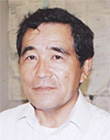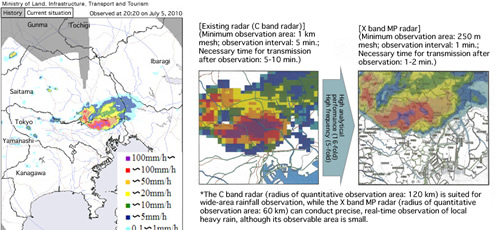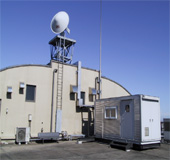Top>Research>Interesting points and importance of water research in the 21st century
 Index
Index

Tadashi Yamada [Profile]
Education Cource
Interesting points and importance of water research in the 21st century
Tadashi Yamada
Professor of civil engineering, anti-disaster engineering, hydraulics, hydrodynamics, hydrology, and meteorology, Faculty of Science and Engineering, Chuo University
1. Introduction
Human beings have made continuous efforts to understand nature since ancient days. Such efforts were intensified as the destruction of natural environments was featured, and it became necessary to understand natural phenomena accurately and implement appropriate measures based on the accurate knowledge. Recent environmental destruction has progressed on a global scale, causing significant damage to atmosphere, soil, and water. In addition to acid rain, the destruction of the ozone layer, and global warming, there are many local issues to be solved, such as the pollution of rivers, lakes, and the sea, etc.
It is necessary to identify the cause of destruction, in order to discuss environmental issues. To do so, steady efforts for understanding nature are required. However, it is very difficult to gauge nature. One measurement data includes various elements. Enormous amounts of labor and time are necessary for analyzing data and clarifying each natural mechanism. There are a variety of methods for exploring nature. The most effective and efficient method for elucidating natural phenomena is to directly touch and observe nature. Thought experiments, numerical analyses, and model experiments are not enough to understand natural phenomena accurately. Accordingly, we established 20 observatories throughout Japan, observed water circulation and hydrological phenomena in various ways, and obtained primary data by ourselves. Our observations and researches into lakes, rivers, and meteorological phenomena will be introduced in the following sections.
2. Observation and analysis of precipitation
Recent torrential rain
In recent years, the frequency of torrential rain with an hourly rainfall amount of over 50 mm is increasing. The lives of people were considerably damaged by the short, local torrential rain mainly in Toyoshima-ku, Tokyo on Aug. 5, 2008 and the Itabashi torrential rain on Jul. 5, 2010, etc. Our laboratory observes such abrupt torrential rain with radar, and pursues researches for clarifying the mechanism of torrential rain and reducing damage.
The Ministry of Land, Infrastructure, Transport and Tourism established the committee for discussing the development and use of the next-generation radar network for monitoring meteorological disasters (X-NET), whose member includes me, and is installing the X-band MP radar in 3 major metropolitan areas. Test operation was started on Jul. 5, 2010. The X-band MP radar can conduct more frequent and more precise observation than the existing radar (Fig. 1: Jul. 5, 2010, Itabashi torrential rain).

Fig. 1: Itabashi torrential rain on July 5, 2010;![]()
The rain with a rainfall intensity of over 100 mm/h continued for over 1 hour.
The mechanism of torrential rain is studied through the observation with Doppler radar

Photo: Outline of the Doppler radar for weather observation of Chuo University
In order to elucidate the mechanism of such torrential rain, which has occurred frequently in recent years, the laboratory of hydrology, Chuo University has observed rainfall in the Korakuen Campus of Chuo University since 1995, by using the X band Doppler radar (photo), which is rare in Japan. The Doppler radar is a meteorological radar for gauging rainfall intensity and the variation in the wind inside the rain area. The data of this Doppler radar for the past 15 years was analyzed, and it was found that rainfall can be classified into several types. Abrupt torrential rain, which has occurred frequently and locally in recent years, can be classified into the front-developed type, the moving multi-cell type, and the single-cell type, whose rainfall range is 20-200 km.
Research for developing a radar raindrop meter and improving the precision of a radar rain gauge
It was found that in order to improve the precision of rainfall observation by meteorological radar, it is necessary to analyze the raindrop size distribution appropriately. Then, our laboratory developed an optical raindrop size meter (laser raindrop meter). By utilizing it, we improved the precision of the radar rain gauge, and study the characteristics of the raindrop size distribution.
3. Clarification of the rainfall mechanism
Research into the effects of sea breeze on local weather
The objective of this research is to clarify the vapor transport process inside the atmospheric boundary layer, which is considered to be related to torrential rain, and the spatial distribution of the density of aerosol (fine particles in atmosphere, which become the nuclei of cloud), which facilitates the formation of cloud. Focusing on the relation between precipitation and land & sea breeze, which is a local circulation in the Kanto Plain, we conduct field observation in the summer in which torrential rain often occurs, and observe the vertical structure of atmosphere with a captive balloon and meteorological factors in the sky with an aircraft.
Quasi experiment of cloud physics using a long bank, and the research into the precipitation process
Our laboratory conducts cloud-physics experiment on a quasi-real scale, by utilizing an exhaust bank for a mine, with the purpose of developing meteorological forecast methods regarding abnormal weather, global warming, and acid rain, which are attracting attention as environmental issues. We succeeded in clarifying the cloud development process and the raindrop growth process, which could not be elucidated with conventional meteorological observation methods (small-scale indoor experiment, aircraft observation, and radiosonde observation), and develop a precise practical model for local precipitation while considering the effects of aerosol (fine particles in atmosphere, which become the nuclei of cloud) based on the results of the cloud-physics experiment.
4. Urban water damage due to torrential rain, and countermeasures
Most of the water damage in urban areas is attributable to the inland flood after torrential rain. Actually, inland flood accounts for over 90% of the damage due to flood in Tokyo. Flood occurs easily in urban areas, because impervious regions increase as urban areas expand and the water discharge capacities of road gutters and sewage lines, etc. The inland flood was simulated while assuming the establishment of rainwater pumping stations, the increase of sewer culverts, the construction of rainwater storage facilities, and the installation of rainwater infiltration measures. The comparison in cost-effectiveness indicates that it is effective to construct rainwater storage facilities. However, it costs a lot of money to establish rainwater storage facilities, and it is difficult to find available land in the urban center. In this circumstance, there is a method of storing rainwater on the rooftop of an existing building, such as rooftop greenery. In addition, we research a method of placing porous pumice stones on rooftops in collaboration with firms, and its simulation indicates that this method is effective.
5. Fundamental research into the characteristics of runoff in mountain watersheds
When it rains on a mountain watershed, some rainwater penetrates into the mountain slope and runs off, while other rainwater flows through the slope into the river. When it rains in a mountain zone, the rainwater penetrates into soil, gets stored in the soil, and slowly flows in the soil as underground water. When it rains, the amount of underground water increases, water flows in the surface layer of the mountain slope, the water reaches the river, and then flood occurs. For river plans, it is important to grasp the phenomena under normal and flood conditions in a mountain region when it rains and when it does not rain. In this research, we developed a new runoff analysis method, while considering the physical processes of rainwater runoff in a mountain region, and compared it with the primary empirical data obtained at our observatories, and then unveiled the detailed mechanism of runoff in mountain regions and rivers, which had been a black box. By combining this analysis and the one-dimensional unsteady-flow numerical analysis of large channel networks, we analyze rainwater runoff in a broad area from a perspective of physics.
6. Drastic reform of river plans are required
The necessity of the construction of Yamba Dam is being discussed. My laboratory has engaged in the development of a runoff model (for analyzing the amount of rainwater runoff to the river), and also the analysis of the flood-control function of Yamba Dam. I suggested that it is necessary to drastically reform river plans about Yamba Dam, etc. For example, when determining the precipitation in plan (rainfall estimated to occur once per several years; e.g. rainfall once per 200 years, for the Tone River and the Arakawa River), the increase in rainfall intensity due to global warming is not taken into account. My recent studies indicate that annual maximum precipitation has a cycle of about 10 years. When these characteristics are clarified, it becomes necessary to produce river plans according to the rainfall amount when precipitation intensity becomes high in the cycle. In addition, an advanced release method was proposed for increasing the flood-control capacity by utilizing existing dams effectively. In this method, the water in the dam is discharged before it rains by utilizing weather forecast, to retain a larger amount of water in the upstream dam. Its simulation indicates high feasibility. According to landform, a river meanders, narrows locally, and becomes shallower. Accordingly, flow volume is low in some places, where flood occurs easily at the time of heavy rain. In order to understand these characteristics, we analyze a water surface profile and conduct hydrological experiments.
7. River and lake environments
For rivers in metropolitan areas, it is important to improve and maintain water quality from the viewpoints of irrigation and river environments, which are targets of river plans. Our laboratory conducts field observation in the lower reach of the Arakawa River, measures the distribution and variation of water quality, and numerically simulates phenomena, with the purpose of the water quality distribution, variation characteristics, and disturbing factors in the tidal river basin inside urban areas (which are influenced by the tide and where seawater enters), which should be considered when drawing up river plans.
8. Conclusion
As mentioned above, my laboratory tackles various water issues, with the purpose of elucidating the water circulation system from the perspective of physics. All of these issues are closely related to other environmental issues. We will make continuous efforts to advance these researches further and solve newly emerging problems.
- Tadashi Yamada
Professor of civil engineering, anti-disaster engineering, hydraulics, hydrodynamics, hydrology, and meteorology, Faculty of Science and Engineering, Chuo University - Born in Hyogo Prefecture in 1951.
Earned a master's degree in engineering, majoring in civil engineering at Graduate School of Science and Engineering, Chuo University in 1976.
Earned a doctoral degree in engineering at Tokyo Institute of Technology in 1981.
Served as assistant at Tokyo Institute of Technology, associate professor at National Defense Academy of Japan, associate professor of Faculty of Engineering, Hokkaido University, associate professor of Department of Civil Engineering, Faculty of Science and Engineering, Chuo University in 1991, professor of Department of Civil Engineering, Faculty of Science and Engineering, Chuo University in 1992, and professor of Department of Civil and Environmental Engineering, Faculty of Science and Engineering, Chuo University from April 2009. - Major social activities (as external member, and council member, etc.):
Member of the operating panel of Water Security Council of Japan
Member of the expert panel of Water Security Council of Japan
Member of the council of intellectuals for discussing future flood-control measures of the Ministry of Land, Infrastructure, Transport and Tourism
Member of the committee for discussing the development and use of the next-generation radar network for monitoring meteorological disasters (X-NET) of the Ministry of Land, Infrastructure, Transport and Tourism
Anti-disaster information task force of the social contribution acceleration project of the Cabinet Office
Director of Japan Society for Natural Disaster Science
Head of the countermeasure subcommittee of the special committee for coping with global warming of Japan Society of Civil Engineers
Member of the investigative commission for radar utilization for river management of the Ministry of Land, Infrastructure, Transport and Tourism
Land water-specialized committee of the liaison committee for the science of atmosphere and hydrosphere of Science Council of Japan
Member of the expert panel of the committee for Science Council of Japan
Member of the committee for evaluating the undertakings of Tokyo
Member of the committee for coping with torrential rain of Tokyo
etc.
- Research Activities as a Member of Research Fellowship for Young Scientists (DC1), Japan Society for the Promotion of Science (JSPS) Shuma Tsurumi
- Important Factors for Innovation in Payment Services Nobuhiko Sugiura
- Beyond the Concepts of Fellow Citizens and Foreigners— To Achieve SDGs Goal 10 “Reduce Inequality Within and Among Countries” Rika Lee
- Diary of Struggles in Cambodia Fumie Fukuoka
- How Can We Measure Learning Ability?
—Analysis of a Competency Self-Assessment Questionnaire— Yu Saito / Yoko Neha - The Making of the Movie Kirakira Megane








